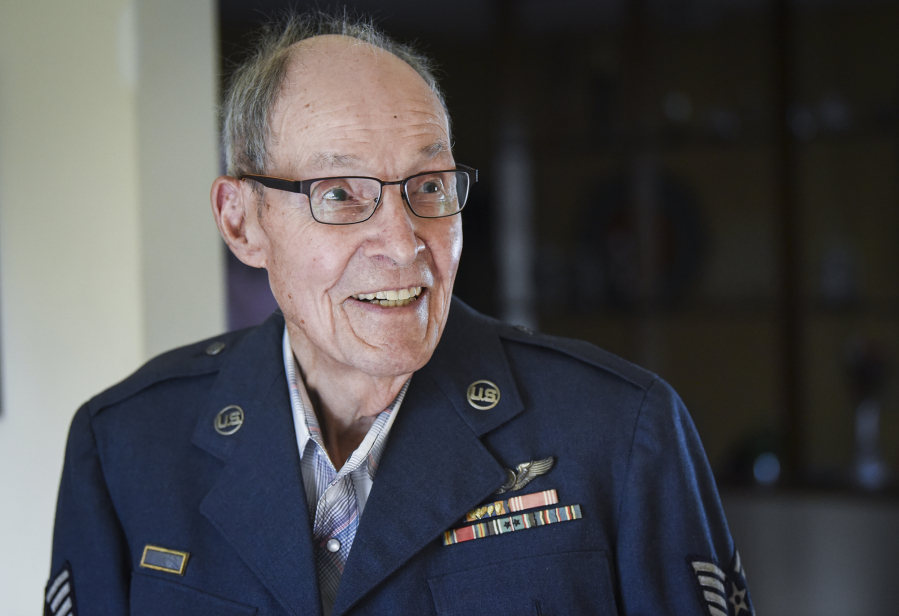As Philip Azure rode in the back of a truck in Arizona, blasting away at skeet with a shotgun, he really wanted to be in Europe.
Those shooting exercises at Kingman Army Airfield were part of aerial gunnery school for World War II bomber crewmen.
“I was afraid the war would end before we got there,” Azure said.
His opinion changed significantly after his first mission over Germany.
“I didn’t realize how bad it was until the first mission,” he said a few days ago in his Vancouver home.
Azure, who also served during the Korean War, wound up flying 35 missions as a B-17 tail-gunner.
His crew was assigned to the 326th Bomb Squadron, 92nd Bombardment Group, 8th Air Force. Now the Vancouver veteran is the last surviving member of his 10-man crew.
Just ahead of Veterans Day, the 92-year-old Azure recalled his view of the air campaign that hammered Germany in 1944 and 1945.
It wasn’t the same view a lot of airmen had. The cockpit crew flew the bomber into the teeth of anti-aircraft fire. Other gunners scanned the skies up, down and sideways. It was the tail-gunner’s job to look behind the Flying Fortress.
“I could see where we’d been,” he said.
Azure didn’t need to see the bursts of flak to know how close they were. You could feel the concussion, he said, “and you could hear shrapnel hit the fuselage.”
‘Murdersburg’
The flak and the enemy fighter planes were fiercest near Merseburg, where Germany operated a massive synthetic oil production center at Leuna.
Azure’s crew flew three missions over Merseburg, which airmen nicknamed “Murdersburg.”
“It was a terrible place. I saw several planes go down,” he said.
“We were very fortunate on the Merseburg missions. We had holes in the air frames of the ships we flew, but no holes in us.”
Azure’s crew was introduced to a new element of German air power on a Merseburg mission. Waist-gunner Sam Lavoi called over the communications system that they were being attacked by what seemed to be an American P-51. It turned out to be a German Me-262 jet fighter.
What Lavoi took to be the wing tanks of a Mustang actually were the twin engines of the Messerschmitt jet.
“He came through so fast, I never got a shot.”
In an account by the crew’s radio operator, Tom Demery wrote that none of his crewmates were ever wounded. But damage from enemy fire almost killed Azure, and it was Demery who came to his rescue.
“Heavy flak knocked out my communications system and my oxygen,” Azure said. “After a raid with heavy fire, the pilot always asked for a check-in.
“I didn’t report. I had passed out. The radio operator crawled back to see what was wrong. He had an oxygen bottle and got me going again,” Azure said. “I guess I wouldn’t have made it if Tom hadn’t come back.”
With the rate of aircraft losses, the replacement process was pretty swift.
Azure’s crew learned that following a raid over Berlin on March 1, 1945. After a fuel tank was shot up, the pilot announced they wouldn’t be able to make it back to their base in Podington, England.
‘Where’s our stuff?’
The B-17 made a pit stop in Belgium and didn’t get back home until late the following day.
When the crew returned to their barracks, “They had moved out all our stuff. We were surprised. We wondered why they did that,” Azure said.
“They were about to declare us missing,” Demery wrote in the newsletter.
There actually was one member of the crew who disappeared — a man who was unable to deal with the prospect of aerial combat. Their bombardier tried to break his foot before the crew went overseas.
“He dropped a brick on it. All he did was bruise it,” Azure said. “On our first mission, when the flak started, he hid behind the navigator.”
The navigator, Henry Nolan, had to drop the bombs. When the B-17 landed in England, that was the end of the bombardier’s stint with the crew.
“We never saw him again,” Azure said.
Azure attended Clark College after the war and also joined the Air Force Reserve. (The U.S. Air Force became a separate branch of the service in 1947.)
He was activated during the Korean War and was a crew chief on a C-119 transport.
After his Army and Air Force hitches, Azure had a long career selling machinery for the plywood industry.
Did You Know?
B-17 Flying Fortress
• Boeing started design work in 1934, and the first flight was in 1935.
• About 12,700 Flying Fortresses were built.
• Normal bomb load for the B-17 was 6,000 pounds.
• Top speed was 287 mph at 25,000 feet, with a range of about 2,000 miles.
• Standard crew and armament was 10 men and 13 .50-caliber machine guns.
An international trade show took him back to Germany — a country he’d visited at 25,000 feet, as he watched bombs explode far below his tail-gun position.
Azure’s return trip in the 1970s featured another significant shift in perspective.
“We weren’t enemies,” he said.




